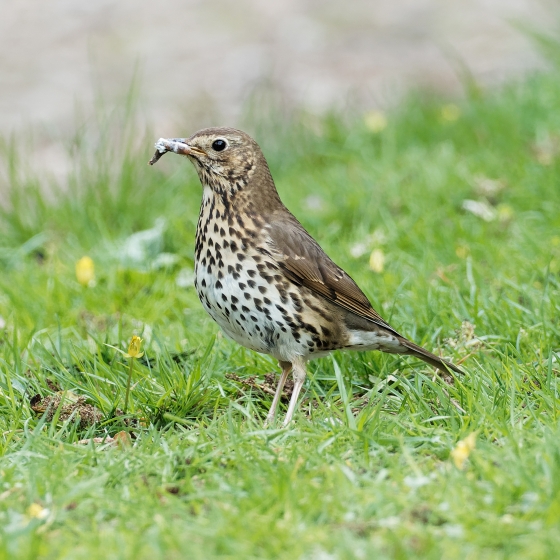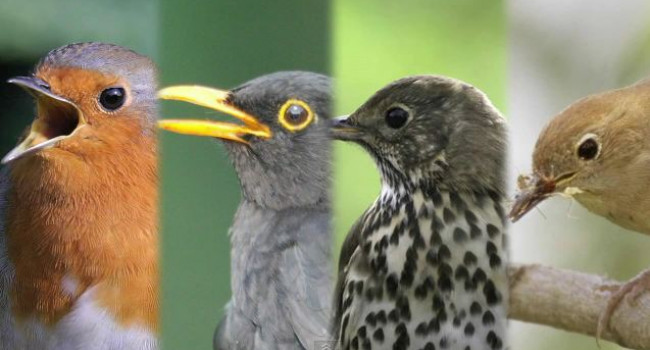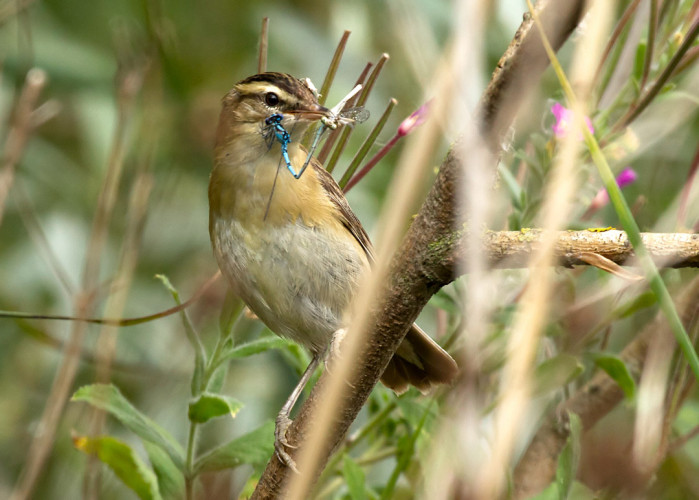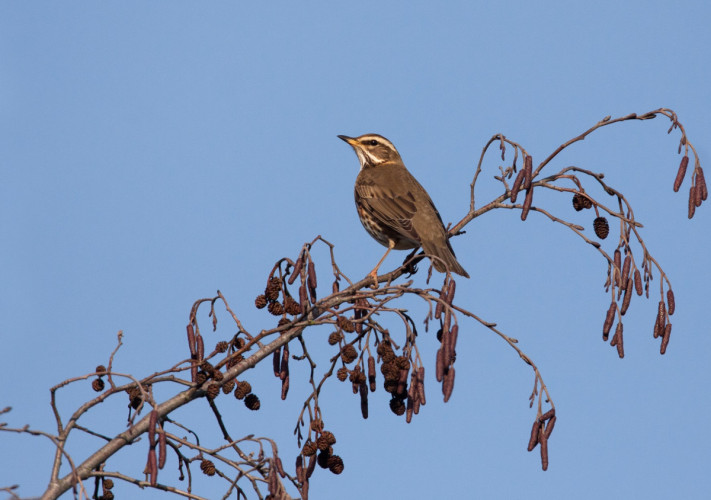Song Thrush
Turdus philomelos (CL Brehm, 1831)
ST
 SONTH
SONTH  12000
12000

Family: Passeriformes > Turdidae

The Song Thrush lives up to its name and is a consummate singer. It is often heard at first light and as darkness falls at the end of the day.
The Song Thrush is essentially a woodland bird that has adapted to use our parks and gardens for feeding and breeding. It is known for its habit of hitting snails against a rock to break the shell and access the soft-bodied prey within; piles of broken snail shells are a good indicator of a bird's presence.
During the 1970s and 1980s, the population underwent a steep decline and many British gardens lost their resident Song Thrush. More recently, there have been signs of a slight recovery. Song Thrushes breed throughout Britain & Ireland. It is also a migrant species, with birds from northern Europe arriving during the late autumn. Some will spend the winter in Britain & Ireland whilst others will head further south as far as North Africa.
Exploring the trends for Song Thrush
Our Trends Explorer will also give you the latest insight into how the UK's Song Thrush population is changing.
trends explorerIdentification
Song Thrush identification is often straightforward. The following article may help when identifying Song Thrush.
Identifying Nightingale and other night singers

Contrary to popular opinion, Nightingale is not the only bird that sings at night. In fact, due to its recent decline, you are more likely to hear other birds singing after dark. This video illustrates the difference in song between the four most common 'Night Singers' - Robin, Blackbird, Song Thrush and of course, Nightingale.
- 1 of 2
- next ›
SONGS AND CALLS
Listen to example recordings of the main vocalisations of Song Thrush, provided by xeno-canto contributors.
Alarm call
Call
Song
Develop your bird ID skills with our training courses
Our interactive online courses are a great way to develop your bird identification skills, whether you're new to the hobby or a competent birder looking to hone your abilities.
Browse training coursesStatus and Trends
Population size and trends and patterns of distribution based on BTO surveys and atlases with data collected by BTO volunteers.
CONSERVATION STATUS
This species can be found on the following statutory and conservation listings and schedules.
POPULATION CHANGE
CBC/BBS showed a steep decline in Song Thrush abundance that began in the mid 1970s. Short-term increases beginning around 2012 mean that the long-term UK decline is now classed as moderate rather than steep, but the population remains substantially lower than in the late 1960s. The latter part of this decline and the recent slight increase can also be seen in the CES index. BBS data from all UK countries show increase from 1995 to 2008, followed by a sharp downturn from 2008 to 2012 and the subsequent increase, but population levels remained relatively low throughout and numbers have again dropped slightly in the two most recent years. The BBS map of change in relative density between 1994-96 and 2007-09 indicates that increase over that period was strongest in Wales and northern England, with little change in Northern Ireland and southeastern England. An increase has occurred across Europe since 1980, following declines in the early 1980s which have since been reversed (PECBMS: PECBMS 2020a>).
| UK breeding population |
-48% decrease (1967–2022) 
|
Exploring the trends for Song Thrush
Our Trends Explorer will also give you the latest insight into how the UK's Song Thrush population is changing.
trends explorerDISTRIBUTION
Song Thrushes were recorded in 94% of 10-km squares in the breeding season and 92% of squares in winter during 2007–11. They were absent only from parts of the Scottish Highlands and Southern Uplands during the winter months. Densities are distinctly higher in Ireland than in Britain in both seasons and abundance is generally greatest in low-lying areas.
Occupied 10-km squares in UK
| No. occupied in breeding season | 2826 |
| % occupied in breeding season | 94 |
| No. occupied in winter | 2756 |
| % occupied in winter | 91 |
European Distribution Map
European Breeding Bird Atlas 2
Breeding Season Habitats
| Most frequent in |
Deciduous Wood 
|
| Also common in | Scrub, Villages, Coniferous Wood |
Relative frequency by habitat
Relative occurrence in different habitat types during the breeding season.

DISTRIBUTION CHANGE
There has been little change in Song Thrush breeding distribution since the 1970s despite large population declines. A more recent small population increase is matched by atlas abundance change maps which indicate an increase in relative abundance in Ireland, Wales, central and southwestern England since the 1988–91 Breeding Atlas.
Change in occupied 10-km squares in the UK
| % change in range in breeding season (1968–72 to 2008–11) | -0.9% |
| % change in range in winter (1981–84 to 2007–11) | +7% |
SEASONALITY
Song Thrush is widely recorded throughout the year, especially in late winter and spring when easily detected by song.

Movement
Information about movement and migration based on online bird portals (e.g. BirdTrack), Ringing schemes and tracking studies.
An overview of year-round movements for the whole of Europe can be seen on the EuroBirdPortal viewer.
RINGING RECOVERIES
View a summary of recoveries in the Online Ringing Report.
Foreign locations of birds ringed or recovered in Britain & Ireland

Biology
Lifecycle and body size information about Song Thrush, including statistics on nesting, eggs and lifespan based on BTO ringing and nest recording data.
PRODUCTIVITY & NESTING
Exploring the trends for Song Thrush
Our Trends Explorer will also give you the latest insight into how the UK's Song Thrush population is changing.
trends explorerSURVIVAL & LONGEVITY
View number ringed each year in the Online Ringing Report
Maximum Age from Ringing 
|
11 years 0 months 8 days (set in 2012) 
|
Typical Lifespan 
|
3 years with breeding typically at 1 year |
Adult Survival 
|
0.563±0.007  
|
Juvenile Survival 
|
0.463 (in first year) 
|
Exploring the trends for Song Thrush
Our Trends Explorer will also give you the latest insight into how the UK's Song Thrush population is changing.
trends explorerBIOMETRICS
Wing Length 
|
Adults | 119.1±3.2 | Range 114–124mm, N=12726 |
| Juveniles | 118.6±2.9 | Range 114-123mm, N=17201 | |
| Males | 120.1±3.2 | Range 115–125mm, N=2915 | |
| Females | 118±2.9 | Range 113–123mm, N=2063 |
Body Weight 
|
Adults | 75.0±7.8 | Range 64.0–90.0g, N=10489 |
| Juveniles | 72.5±8.1 | Range 59.0–86.0g, N=13969 | |
| Males | 77.7±6.8 | Range 67.0–90.0g, N=1669 | |
| Females | 71.0±4.7 | Range 64.0–79.0g, N=2339 |
Feather measurements and photos on featherbase 
CODES & CLASSIFICATION
Ring size 
|
CC |
Field Codes 
|
2-letter: ST | 5-letter code: SONTH | Euring: 12000 |
For information in another language (where available) click on a linked name
Research
Interpretation and scientific publications about Song Thrush from BTO scientists.
CAUSES AND SOLUTIONS
Causes of change
Changes in survival in the first winter, and also the post-fledging period, are sufficient to have caused the population decline. The environmental causes of this are unknown but are likely to include changes in farming practices, particularly land drainage and possibly increased pesticide usage.
Further information on causes of change
CES productivity shows an initial decrease, followed by fluctuations around a new lower level, and the number of fledglings per breeding attempt increased during the 1980s and 1990s but has since decreased (see above). There is good evidence to show that changes in survival in the first winter have contributed to the population decline (Thomson et al. 1997, Siriwardena et al. 1998b, Robinson et al. 2004). A more recent integrated analysis also indicated that post-fledging survival also made some contribution to annual population changes (Robinson et al. 2014).
Peach et al. (2004) suggested that loss of hedgerows, scrub and permanent grassland with livestock and the widespread installation of field drainage systems, all of which would act to reduce the availability of good quality foraging areas, have probably contributed to the decline of the Song Thrush in the UK. Similarly, it has been suggested that the species is unable to survive the winter in woodland, due to a lack of food, and a reduction of food supply in other habitat types has also been reported (Simms 1989). It is likely that a reduction in food supply would adversely affect the survival of juvenile birds to a greater extent than adult birds, as appears to be the case (Robinson et al. 2004). Furthermore, survival is reduced during periods of long drought or cold weather when food is likely to be less available (Robinson et al. 2007). However, modelling suggests that climate change may have had a positive impact on the long-term trend for this species, resulting in less negative trends than would have occurred in the absence of climate change (Pearce-Higgins & Crick 2019).
In woodland, drainage of damp ground and the depletion of woodland shrub layers through canopy closure and deer browsing may also be implicated (Fuller et al. 2005). There is also some concern of the impact of overgrazing by deer (e.g. Gill & Beardall 2001) and canopy closure (Mason 2007), due to changes in woodland management (Hopkins & Kirby 2007) on the low woodland layers, although good evidence from the UK is sparse (but there are some experimental studies in America on different species which demonstrate this effect, e.g. McShea & Rappole 2000). A study based on BBS results from 1995 to 2006 found a negative correlation between the abundance of deer and Song Thrush, with the species declining the most where deer population increase had been greatest, although the size of the impact was relatively small with modelling suggesting that deer could have caused a decline of around 4% over this period (Newson et al. 2012). Several papers (e.g. Gosler 1990, Perrins & Overall 2001, Perrins 2003) state that the understorey has declined in Britain, but few data are available to support this on a national scale. However, Amar et al. (2006) found a 27% increase in understorey in the RSPB sites used in the Repeat Woodland Bird Survey.
Robinson et al. (2004) suggested that predation was a possible cause of reduced survival but there is conflicting evidence on the role of predators in Song Thrush decline, and further research is needed. Newson et al. (2010b) found no evidence of effects of avian predators or grey squirrels on Song Thrushes.
Information about conservation actions
Like its close relative the Blackbird , the Song Thrush declined substantially during the 1970s and 1980s. Numbers have subsequently remained low despite recent slight increases. The decline was probably caused by changes to post-fledging and first winter survival and hence actions to increase food availability may benefit Song Thrush. These could include providing supplementary food over winter, managing hedgerows or woodland habitat for wildlife, and providing additional habitat, e.g. wild bird seed or cover mixtures, set-aside or grass buffer strips/margins.
As well as the removal of habitat such as hedgerows and scrub, loss of livestock (along with associated grasslands) and field drainage may also have reduced the amount of good quality foraging habitat, with field drainage being linked to the availability of earthworms (Peach et al. 2004). Peach et al. (2004) recommended that "new policy initiatives should aim to restore nesting cover (scrub and woodland understorey), grazed grasslands in arable dominated areas and damper soils in summer". Kelleher & O'Halloran (2010) also stressed the need to provide good nesting cover as a conservation action for Song Thrush and stated that dense vegetation was important when Song Thrushes were choosing a nest-site. Management actions which could help to increase the undergrowth and ground layers include opening up the canopy and control of deer numbers.
Like Blackbird, Song Thrush is a partial migrant, and local conservation actions to support birds in winter will not necessarily benefit local populations, so changes over a large scale may hence be required in order for actions to have a significant effect on British (and European) populations.
PUBLICATIONS (2)

Declines in invertebrates and birds – could they be linked by climate change?
Are the declines of birds and invertebrates linked by climate change?
Many of the detected effects of climate change on biodiversity have occurred through impacts on food chains.

Nocturnal flight calling behaviour of thrushes in relation to artificial light at night
Nocturnal thrushes affected by artificial light
New research from BTO has investigated the effect of artificial light at night on birds, indicating that nocturnal migrants are attracted to more brightly lit areas.
Links to more studies from ConservationEvidence.com
- Composition of cavity-nesting bird communities in montane aspen woodland fragments: the roles of landscape context and forest structure
- Response of bird communities to silvicultural thinning of Mediterranean maquis
- Could game management have a role in the conservation of farmland passerines? A case study from a Leicestershire farm
Read more studies about Song Thrush on Conservation Evidence >
Would you like to search for another species?













Share this page